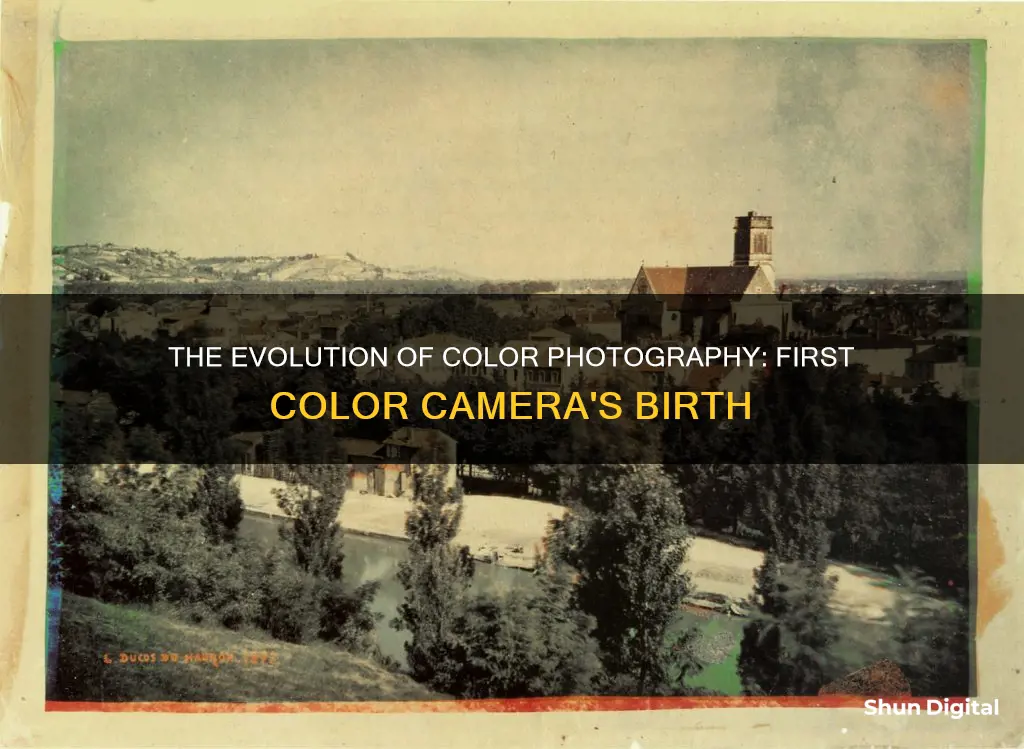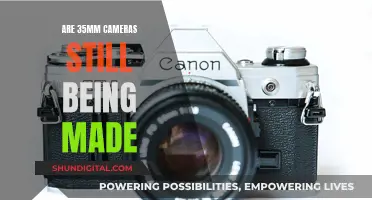
The first colour photograph was taken in 1861 by Thomas Sutton, using red, green and blue filters. However, the process was not ready for common use until the 1960s and 1970s, when colour photography became accessible to amateur home photographers.
| Characteristics | Values |
|---|---|
| Year of first colour camera | 1861 |
| Inventor | Scottish physicist James Clerk Maxwell |
| Method | Three-colour method |
| First colour photograph | Ribbon made of tartan |
What You'll Learn
- The first colour photograph was taken in 1861 by Thomas Sutton, using red, green and blue filters
- The first colour photograph was demonstrated by James Clerk Maxwell in 1861, using three lantern slides of a tartan ribbon
- The first commercially successful colour process was the Lumière Autochrome, which was mass-produced in 1907
- Kodachrome, the first 'integral tripack' system, was released by Kodak in 1935
- Colour photography became accessible to the masses in the 1970s

The first colour photograph was taken in 1861 by Thomas Sutton, using red, green and blue filters
The development of colour photography was a long and complex process, with many scientists, photographers, businessmen and experimenters contributing to its evolution. The search for a means of capturing colour began as soon as the first photographs were revealed to the public in 1839. Despite the wonder that these early images provoked, there was also disappointment that they failed to record the colours of nature accurately.
The first colour photograph was the result of a collaboration between Sutton and Scottish physicist James Clerk Maxwell. Maxwell had conducted experiments to demonstrate that all colours can be made by mixing red, green and blue light. He suggested that this theory could be applied to photography by taking three separate images of the same subject, each through a different coloured filter. When these images were projected together onto a screen, they combined to form a full-colour image. This process, now known as the three-colour method, became the foundation of virtually all practical colour processes, whether chemical or electronic.
Sutton's photograph of a bow made from ribbon, taken using Maxwell's three-colour method, was the first durable colour image. However, it was not without its flaws. Historians have noted that the photographic process used by Sutton was insensitive to red light and only marginally sensitive to green. Despite this, Sutton's image successfully reproduced the colours of the original subject, marking a significant achievement in the development of colour photography.
Following Sutton and Maxwell's pioneering work, further advancements were made by other scientists and inventors. In 1891, Gabriel Lippmann announced a colour process based on light interference, for which he was awarded the Nobel Prize in 1908. In the early 20th century, French brothers Auguste and Louis Lumière invented the first commercially successful colour process, the autochrome. This was followed in the 1930s by the introduction of the first modern "integral tripack" colour film, Kodachrome, by the Eastman Kodak company.
Unlocking Camera Raw: Unlicensed Lightroom Upgrade Secrets
You may want to see also

The first colour photograph was demonstrated by James Clerk Maxwell in 1861, using three lantern slides of a tartan ribbon
The first colour photograph was demonstrated by physicist James Clerk Maxwell in 1861. The image, a tartan ribbon, was created using three lantern slides, each taken through red, green, and blue filters. Maxwell then projected the three images onto a screen, using three separate magic lanterns, each equipped with a matching coloured filter. When the images were superimposed, they combined to make a full-colour reproduction of the original ribbon.
This demonstration was the first time a durable colour image had been captured photographically. The three-colour method was first suggested by Maxwell in an 1855 paper on colour vision. The first colour photograph made according to this method was taken by Thomas Sutton, for use in illustrating a lecture on colour by Maxwell.
The three-colour method is the foundation of virtually all practical colour processes, whether chemical or electronic. It involves analysing the spectrum of colours into three channels of information: one dominated by red, another by green, and the third by blue. This imitates the way the normal human eye senses colour.
Despite this breakthrough, colour photography remained impractical for several decades. Early colour photographs required long exposure times, and photographic materials sensitive to the full range of the colour spectrum were not yet available. It wasn't until the 1900s that colour photography became more widely used, with the Lumière brothers' autochrome process, and the first commercially successful 'integral tripack' system, Kodachrome, in 1935.
Unraveling Time-Lapse Photography: Capturing the World in Motion
You may want to see also

The first commercially successful colour process was the Lumière Autochrome, which was mass-produced in 1907
The Autochrome was simple to use, as photographers could use their existing cameras. However, exposure times were long, requiring at least one second of exposure in bright sunshine and up to ten seconds or more in cloudy weather. In a well-lit studio, portraits could take as long as 30 seconds. Despite this, millions of Autochrome plates were manufactured and used for a couple of decades, before film-based versions appeared in the 1930s.
The Lumière brothers' method was not without its drawbacks. The plates were expensive, costing about as much as a dozen black-and-white plates of the same size. The long exposure times also made handheld snapshots and photographs of moving subjects impractical. Finally, the finished image was quite dense due to the presence of the light-absorbing colour screen.
Despite these limitations, the Autochrome was a significant milestone in the history of colour photography, paving the way for future innovations and making colour photography accessible to a wider audience.
Are Batteries Included? Camera Shopping Basics
You may want to see also

Kodachrome, the first 'integral tripack' system, was released by Kodak in 1935
Kodachrome, released by Kodak in 1935, was the first commercially successful "integral tripack" system. This was a significant development in the history of colour photography, which had been a long and difficult quest.
The "integral tripack" system was not a new idea. In 1912, Rudolph Fischer patented a proposal to use "colour couplers" to create coloured dyes during the development of a multi-layer film. However, the couplers Fischer used tended to disperse between the emulsion layers, and the process was never commercialised.
Kodachrome built on Fischer's work. It was the brainchild of Leopold Mannes and Leopold Godowsky, two professional musicians who spent their spare time experimenting with colour photography. In 1922, they met with Dr C.E. Kenneth Mees, director of the Eastman Kodak research laboratories in Rochester, New York. Impressed with the quality of their work, Mees agreed to supply them with the materials they needed to continue their research.
Mannes and Godowsky initially worked on a two-colour subtractive system. However, after reading about Fischer's work with colour couplers, they decided to switch to a three-colour multi-layer film system. In 1931, they gave up their musical careers to work full-time in the Kodak research laboratories, where they made rapid progress with the support of Eastman Kodak's enormous resources.
Kodachrome was, in effect, a black-and-white film to which coloured dyes were added during processing. The process was extremely complex, requiring at least 28 different stages that could only be carried out in laboratory conditions. For this reason, photographers were unable to process their own film and had to send it back to the Eastman Kodak laboratories in Rochester.
Kodachrome film first went on sale on 15 April 1935 for use in 16mm cine cameras. 35mm Kodachrome film was available on the American market in 1936, and the first supplies reached the UK in 1937.
Traditional Cameras: Still Relevant or Obsolete?
You may want to see also

Colour photography became accessible to the masses in the 1970s
The first colour photograph was unveiled by Scottish physicist James Clerk Maxwell in 1861. However, colour photography was not popularised until the 1930s, and even then, it was still a cumbersome and expensive process. It was only in the 1970s that colour photography became the dominant form of photography, with monochrome photography mostly being used in niche markets such as art photography.
The everyday home photographer likely didn't switch to colour photography until the 1960s or 1970s. This was due to a combination of factors, including the higher cost of colour film, the unreliability of colour photographs in indoor lighting, and the longer exposure times required by early colour photography processes.
The first colour photographs were created by taking the same photo three times through red, green, and blue filters, and then assembling a final full-colour image. This was a complex and time-consuming process that required specialised equipment and skilled technicians.
The development of colour film by companies like Kodak and Agfa in the 1930s made colour photography more accessible, but it was still more expensive and technically challenging than black-and-white photography. It wasn't until the 1970s that prices had decreased enough to make colour photography widely accessible to amateur photographers.
The popularisation of colour photography was also influenced by advancements in colour film technology, such as the development of more sensitive emulsions and the incorporation of dye couplers into the emulsion layers, which simplified the processing of colour film.
By the 1970s, colour photography had become more affordable, reliable, and user-friendly, making it accessible to the masses and leading to its widespread adoption.
Charging the Kodak Easyshare C1450: A Simple Guide
You may want to see also







